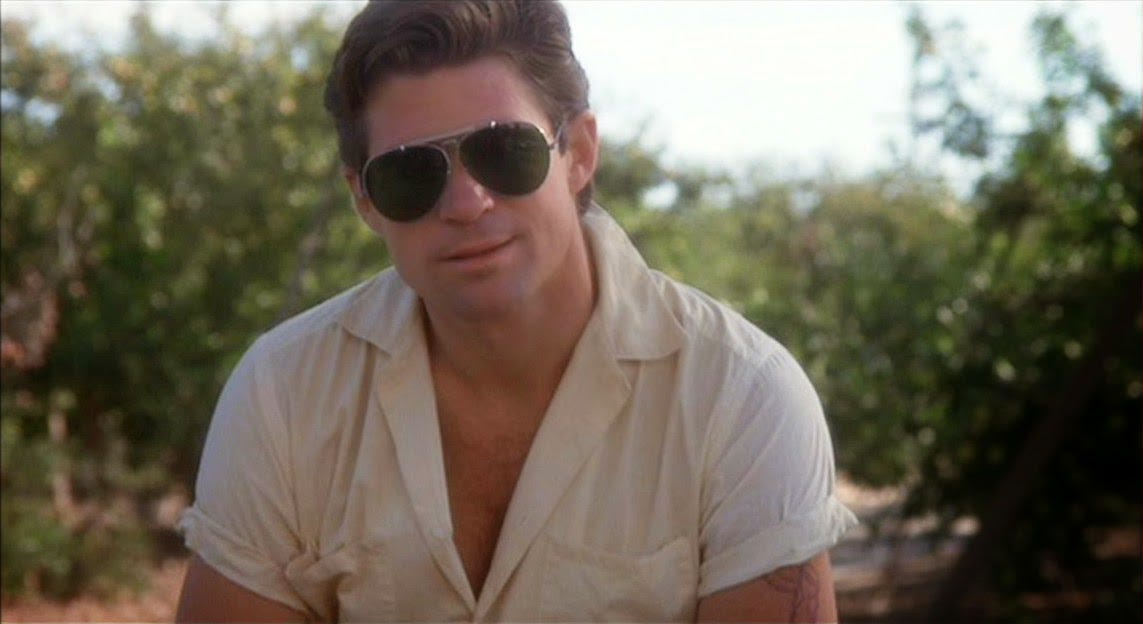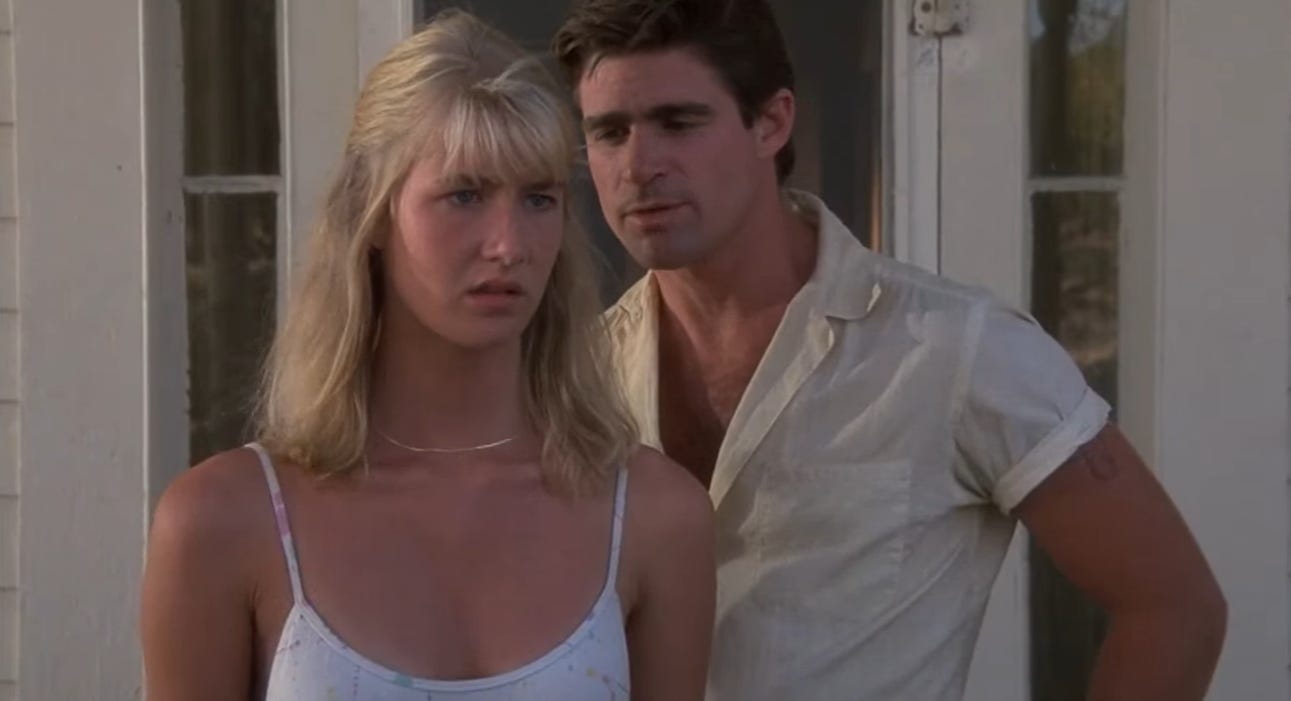A. Friend in Low Places: On Treat Williams in 'Smooth Talk'
In one of the late actor's signature roles, Treat Williams brings a sinister confidence to the predator of Joyce Carol Oates' "Where Are You Going? Where Have You Been?"
Published in 1966, the Joyce Carol Oates short story “Where Are You Going, Where Have You Been?” had long been a staple of Englsh-class anthologies, where students could unpack the symbolism and ambiguities of a 15-year-old’s disturbing coming-of-age. But its familiarity did not, by any means, make it a natural candidate for a full-length feature. For one, there’s not much plotting in Oates’ story, which hinges on a major scene in which Connie, a teenager coming to grips with her nascent sexuality, gets beckoned out of her house by Arnold Friend, a much older stranger with a gold convertible and bad intentions. The larger problem, however, is the dreamlike nature of the story: Are we supposed to understand Arnold Friend (“A. Friend”) as a real person or does he merely represent a loss of innocence and the predatory world of men? Films are literal-minded by nature, and seeing the action play out as written would threaten to spoil the mystery.
Treat Williams had an answer for that. In the 1985 film Smooth Talk, written by Tom Cole and directed by Joyce Chopra, Williams plays Arnold with a serene self-confidence that glistens like a razor’s edge. He looks like a man out of time, like a sinister James Dean type who never changed his appearance and never stopped targeting high school girls. (Imagine a creepier version of Matthew McConaughey in Dazed and Confused: “I keep getting older. They stay the same age.”) The delicate dance that Williams is trying to pull as Arnold is suggesting menace while minimizing the overt threat of violence in Oates’ story. His goal is to get Connie to submit to him, despite her instinctual (and justifiable) fear, and that requires an even, insistent tone. He has to make it seem like she has no other option than to yield. That’s smooth talk.
Williams died two days ago in a motorcycle accident at age 71. In the hours before the accident, his Twitter feed made it seem like he’d gone to Heaven early, with shots of him mowing the yard (“Wish I could bottle the scent”) and tending to the grass clippings in a blissful slice of rural Vermont. Though he picked up a few bit parts in the mid-1970s, Williams broke through with significant roles in two huge ensemble pieces in 1979, Milos Forman’s Hair and Steven Spielberg’s 1941. And just two years after that, he would take on what’s perhaps his signature role in Sidney Lumet’s Prince of the City as Daniel Ciello, a narcotics officer who makes the torturous decision to expose corruption in the force, only to lose everyone in his life, including the partners he’d sworn to protect. (Williams would put in a cameo in the HBO series We Own This City, which used Prince of the City as a primary source of inspiration.)
As beautifully as Williams carried Prince of the City as a leading man, he would mostly be known as a “That Guy”-style character actor, someone who could get tucked eight or nine names deep in the cast and be relied upon to deliver the goods. In later years, he found more of a home on television, with regular and recurring roles over multiple seasons on hits like Everwood (2002-2006), Chicago Fire (2013-2018), and Blue Bloods (2016-2023). But those earlier roles had a little danger to them, because Williams had a way of masking a dark soul under conventional good looks and an easy charisma. The movies didn’t do enough to exploit his potential beyond a sturdy plug-and-play type who could fill out the roster.
As with Oates’ short story, Smooth Talk is told through Connie’s perspective, so Chopra and Cole limit Arnold’s appearances in the first two-thirds of the film, much like the shark in Jaws. Instead, they spend a remarkable amount of time sketching Connie’s life as a restless, rebellious teenager who scraps with her mother (Mary Kay Place) and oh-so-perfect sister (Elizabeth Berridge), and starts to experiment with boys. Laura Dern starred in Smooth Talk and David Lynch’s Blue Velvet in successive years, and both of her characters embark on parallel journeys of innocence lost, though Connie is the more sexually provocative of the two. She’s at a point in her life where she recognizes that her body has power and she’s curious about how she can use it, but at the same time, she isn’t quite certain how far she’s willing to go and she’s frighteningly naive to the threats bearing down on her.
Arnold picks up on that immediately, like a hungry lion spotting a gazelle on the savanna. Wearing a skimpy new halter top under her sweatshirt, Connie convinces a friend to go with her to Frank’s, a restaurant that doubles as a pick-up spot for high-schoolers and young adults. She expects to get hit on at Frank’s, especially once she loses the sweatshirt, but she operates under the illusion that she can handle the guys who proposition her—which might be true of boys her age, but isn’t true of a man like Arnold. Before Arnold resurfaces for the seduction sequence that makes up almost a third of Smooth Talk’s running time, he only gets one chilling line outside Frank’s: “I’m watching you,” he says, pointing in Connie’s direction. She walks away without thinking much of it. Even at 15, she’s used to being harassed.
There’s great value in the time Chopra spends with Connie in the first hour of Smooth Talk, particularly in her tortured relationship with her mother, who’s both alarmed by her daughter’s behavior and somewhat resentful of her youth. She knows that Connie lies to her about where she’s been—Connie keeps going back to see a movie that she doesn’t like for some reason—and has enough experience to know her daughter is inviting trouble, though probably not of this magnitude. The tension between them only drives Connie further into rebellion, which makes every encounter she has at the mall or at Frank’s seem like disasters waiting to happen. There are plenty of Arnolds out there. A 15-year-old doesn’t have the experience to suss them out. The freeway she crosses to get to Frank’s feels like a metaphor in itself.
When Smooth Talk reaches The Scene, Arnold has Connie cornered in her own home. After another fight with her mother, Connie has passed on joining her family for a barbecue, which gives her a free afternoon to work on her tan and laze about the house. Turning up with a taciturn buddy in a gold convertible with his name in calligraphy on the door, Arnold seems to know everything about her, like the names of all her friends or the details on the barbecue, which he knows is 12 miles away “as the crow flies.” This is perhaps the biggest hint that Arnold may not be real, but the rest of the scene really does operate in that gray area, teasing between the abstract and the visceral.
In a video interview for the Criterion edition of the film, Williams talks about his approach to Arnold like an actor who comes into a scene with a clear goal, which here is to get Connie to leave the house and go on a ride with him. He can intimate her and manipulate her, but he doesn’t want to terrorize her. In one particularly brilliant improvisation by Williams, Arnold turns her attempt to retreat back to the house as a silly, whimsical dance, playfully miming her movements as a way of disarming her while still actively getting in her way. Connie wants this nightmare to end, but Arnold wants to make it seem like her only option is to come with him. It’s like a cruel rite-of-passage that he’s arranged for her, and both short story and movie strongly imply that their interaction leads to a rape.
The ending of Smooth Talk reserves some hope for Connie to find her footing again after this experience. When Arnold drops her off at home, she turns back toward him with a resolute expression we’ve never seen from her before: “I don’t want to see you here again. Ever. Understand?” Nothing much changes in Williams’ expression in this moment. Arnold seems neither surprised by Connie’s rebuke nor particularly alarmed by it—at worst, he’s a little bemused and smug in the face of it. He’s gotten what he wanted out of this girl, and now it’s time for him to go back to the savanna. There will be others.






This is the movie I immediately thought of at the news of Treat Williams’s death. Both the movie and his performance are gripping, horrifying, and so, so powerful. I was lucky enough to see this as an 18-year-old at Sundance (actually still called the U.S. Film Festival way back then). I could afford a ticket to see just one film, and this was the one I picked. It went on to win the Grand Prize.
The film has stayed with me all these years. I watched it again last year and was relieved to find it still had the same malevolent power. Even if there was no rape, you still leave the film feeling like something has been lost at a terrible price.
What a great movie; I feel it’s nowhere near as well-known as it should be. I watched it last year on Criterion Channel.
The depiction of the tension between a mom and teenage daughter is so real. There’s love there, but it can be very difficult for moms and daughters to get through the teenage years unscathed.
I read the story after watching the film; Oates’s story is brief, and a lot of flesh needed to be added to its bones to make a 2-hour feature. The writer and director managed to skillfully add to the story without taking anything away.
I feel that woman-directed pictures often have more nuance and depth regarding how relationships are portrayed. Another example being *Valley Girl* which has far more nuance than its teen-comedy premise implies.
“In one particularly brilliant improvisation by Williams, Arnold turns her attempt to retreat back to the house as a silly, whimsical dance, playfully miming her movements as a way of disarming her while still actively getting in her way.”
YES! Williams is so wonderfully oily here. This is the moment that crystallizes the awesome creepiness of his performance. It put me in mind of the penultimate scene of *Annihilation* where the alien being mirrors Natalie Portman’s movements (although she then defeats [?] the alien by turning this mirroring against it).